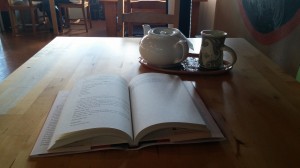In which there is tea.
Camelia Sinensis: (n.), the white-flowered evergreen shrub that is the origin of all teas. Family Theaceae, Genus Camelia, from the Latinized name of the Reverend Georg Kamel (1661-1706), a Jesuit missionary to the Philippines who made substantial contributions to seventeenth century botany. Sinensis, Latin for “from China”.
To my dear reader,
I sit in Ubiquitous Journey – a sandwich and tea shop that is my favorite off-campus location in Tacoma – and after having stumbled upon Keith Souter’s The Tea Cyclopedia: A Celebration of the World’s Favorite Drink, I have begun to wonder about the drink. I have Nickelodeon to thank for the beginning of my love of tea, due to my love of the character Iroh in the TV show Avatar: The Last Airbender and his love for the beverage, but tea has since extended beyond my relationship with that TV show. The complexities of tea fascinate me; the intricacies of its creation are baffling, the delicacy needed to blend it enormous.
There are six families of true tea – white, yellow, oolong, green, black and pu-erh – of which all are made from the Camelia Sinensis, while floral, herbal and fruit teas are delicious falsities, not containing the tea bush’s leaves and therefore not being true teas. Each family of tea has its own creation process and therefore its own distinctive flavor, and all have great health benefit, such as the tumor and apoptosis inhibiting ability of tea’s polyphenols or the antioxidant abilities of tea’s catechins. Tea has been used in all manner of literary adventures, from the Hatter’s tea party in Lewis Carol’s Alice’s Adventures in Wonderland to the teashop setting of Baroness Orzy’s Old Man in the Corner, and tea’s beauty has inspired the lineage of tea literature from Lu Yu’s Ch’a Ching (The Classic of Tea), c.770, to Kakuzo Okakura’s 1911 volume The Book of Tea, to Keith Souter’s The Tea Cyclopedia: A Celebration of the World’s Favorite Drink itself.
But what interests me most is the use of tea in social interaction. The Taiwanese tea tradition uses the Perennial Tea Ceremony as an opportunity for participants to celebrate the seasons, elements and philosophy together, while the Moroccan tea tradition calls polite conversation over three servings of maghrebi mint tea after dinner. As eighteenth century dining customs changed to suit the increasingly industrial society, and the midday and evening meals grew ever farther apart, afternoon tea was invented to tide the upper classes over and allow for diversionary social interaction in the intervening time.
I, however, used tea in an enjoyable and completely accidental social interaction between me (as I sat in Ubiquitous Journey) and a fellow Puget Sound student that happened to have stumbled upon the shop. We ordered sandwiches and soup together, and feeling inspired by reading The Tea Cyclopedia, I decided that I would offer her a cup of my Hairy Crab Oolong tea.
“What you tried this one before?” she asked.
“Oh no,” I replied, “But that’s part of the adventure.”
There is a saying in the United Kingdom, Keith Souter writes, that goes “I’ll be Mother” if one desires to be the one to pour tea for others. There is speculation that this originates from old fertility practices, wherein a woman hoping to conceive would serve drinks unto others as part of a ritual. Whatever the origin of the saying, however, I immediately took a liking to it and, when this friend from Puget Sound reached to pour her own cup, I waved her hand away and said “I’ll be Mother!”
Something that no one tells you about college is that not only do you must learn to speed to catch up with all the things you must learn, but also must learn to slow down to a rate of life that is healthy and reasonable. Drinking tea, to me, is a purposeful act of slowing down, no matter how rapidly the world is shifting. Drinking tea with another, to me, is an invitation for another to enjoy a moment with just you in just that very moment – a difficult thing to do.
As I later learned, “being mother” also entails pouring milk into the cups of those that want it, offering sugar cubes rather than a bowl of granulated sugar, and using tongs to lift the cubes. But never mind this, and never mind my inadequate knowledge of tea practices and traditions! For it is a learning process, and one day, I shall be mother indeed.
With all due respect,
Daniel Wolfert
P.S. I highly recommend the Hairy Crab Oolong. It was delicious.



